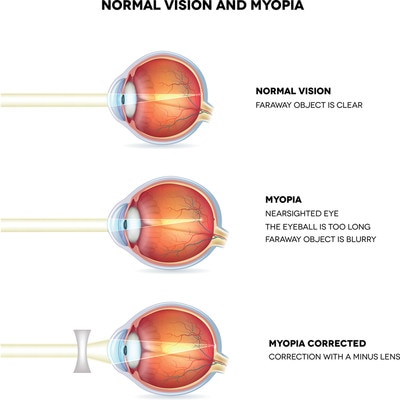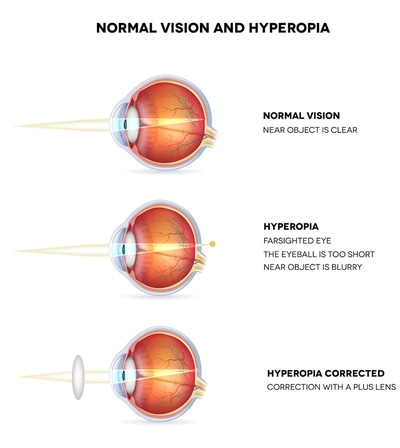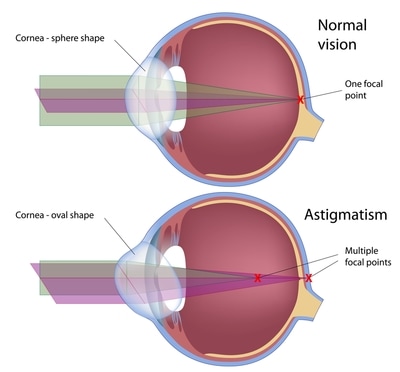First, here's an explanation about REFRACTIVE ERRORS, the reason most people need glasses
Refractive Error
REFRACTIVE ERROR is a condition of the eye in which light is not focussed on the retina. There are three types of refractive error: Myopia, Hypermetropia and Astigmatism. When untreated, myopia, hypermetropia and astigmatism may cause symptoms which include headaches and eye strain.
Myopia
MYOPIA (Near-sightedness or Short-sightedness) occurs when light is focused in front of, instead of on, the retina. Distant objects are blurry while near objects appear clear. If severe, near-sightedness can increase the risk of retinal detachment, cataracts, and glaucoma.
Hypermetropia or hyperopia
HYPERMETROPIA (Far-sightedness, long-sightedness or hyperopia) occurs when light is focused behind, instead of on, the retina. Near objects are blurry, while distant objects may appear normal. If severe, objects at all distances are blurry. People with hyperopia can also experience difficulty changing focus to view near objects (accommodative dysfunction), trouble working the eyes together (binocular dysfunction), one 'lazy' or weak eye (amblyopia), and a 'turned' eye strabismus.
Astigmatism
ASTIGMATISM is a condition of the eye in which light does not focus evenly on the retina. This results in distorted or blurred vision at all distances. If it occurs early in life and left untreated it can result in amblyopia.
Presbyopia or Dysfunctional Lens Syndrome (DLS)
PRESBYOPIA
The natural ability of the eye to change focus from distance to near is gradually lost from the age of 40. The condition of presbyopia occurs when you have to move things away from you to see them clearly and is the reason most people have to wear magnifiers or reading glasses in their 40s to 50s. It happens because the naturally flexible eye lens stiffens with age.
The natural ability of the eye to change focus from distance to near is gradually lost from the age of 40. The condition of presbyopia occurs when you have to move things away from you to see them clearly and is the reason most people have to wear magnifiers or reading glasses in their 40s to 50s. It happens because the naturally flexible eye lens stiffens with age.
Treatment of Refractive Errors

TREATMENT
Refractive Error can be corrected by spectacles, contact lenses or surgery.
Refractive Error can be corrected by spectacles, contact lenses or surgery.
Vision Correction Surgery for Refractive Errors
SURGERY
Permanent correction of refractive error can only be achieved by surgery. The choice of which form of surgery best suits you depends on many factors including your age, type of refractive error, lifestyle and associated eye conditions. Your surgeon is the best person to assess your requirements and discuss with you the best option for your circumstances.
The types of surgery available can be categorised into:
Permanent correction of refractive error can only be achieved by surgery. The choice of which form of surgery best suits you depends on many factors including your age, type of refractive error, lifestyle and associated eye conditions. Your surgeon is the best person to assess your requirements and discuss with you the best option for your circumstances.
The types of surgery available can be categorised into:
Laser Eye Surgery
Laser eye surgery generally is suitable for people under 35 years of age who have short-sight and do not have very large refractive errors (that is, mild to moderate myopia and astigmatism). Although people with hypermetropia (or long sight) can have this surgery, the results are not as stable in the long term. Laser surgery reshapes the eye and these changes cannot be reversed. Results of laser surgery are very good and the outcomes are time-proven. However, regression is known to occur in some instances, where refractive errors slowly develop again after surgery, although these changes can take many years. Occasionally, subsequent treatments (or enhancements) are needed, but there is a limit to how many enhancements can be performed.
Some patients are unsuitable for laser eye surgery for example, if the cornea is too thin or if there is excessive astigmatism.
Because laser surgery changes the shape of the cornea, this may limit the options later in life when a cataract forms (this happens in most people in their 50s-60s). For instance, the use of multifocal and toric intraocular lenses may cause difficulties with significant glare in patients who have previously had LASIK or ASLA/PRK.
Some patients are unsuitable for laser eye surgery for example, if the cornea is too thin or if there is excessive astigmatism.
Because laser surgery changes the shape of the cornea, this may limit the options later in life when a cataract forms (this happens in most people in their 50s-60s). For instance, the use of multifocal and toric intraocular lenses may cause difficulties with significant glare in patients who have previously had LASIK or ASLA/PRK.
Non Laser Eye Surgery
Non laser surgery is suitable for both younger patients and older patients. Small, medium and large refractive errors can be treated including astigmatism.
Implantable Collamer (or Contact) Lens (ICL) or Phakic IOL
In younger patients who have Implantable Collamer Lens (Intraocular Contact Lens or Phakic IOL) surgery, the lens can be removed and replaced if necessary. Therefore the operation is reversible and the power of the ICL can be changed should a change in vision occur even years after surgery. Importantly, the quality of vision with an ICL is superior when compared to the vision obtained with laser surgery (both LASIK and ASLA/PRK).
When a cataract develops later in life, the ICL and cataract can be removed in the same operation and an intraocular lens implanted. Unlike with laser surgery such as LASIK or ASLA/PRK, a previous ICL operation does not limit your options for multifocal or toric IOL implants with cataract surgery. So people who have an ICL operation when young can still look forward to a much better chance of being spectacle free in their later lives.
When a cataract develops later in life, the ICL and cataract can be removed in the same operation and an intraocular lens implanted. Unlike with laser surgery such as LASIK or ASLA/PRK, a previous ICL operation does not limit your options for multifocal or toric IOL implants with cataract surgery. So people who have an ICL operation when young can still look forward to a much better chance of being spectacle free in their later lives.
Refractive Lens Exchange (RLE)
In many older patients (over 40) and some younger ones, Refractive Lens Exchange may be suitable. In this procedure, the eye's natural lens is removed and replaced with an artificial intraocular lens, or IOL, of the correct power.
Click on the buttons below for a full description of each of the options available:
YOUR VISION CORRECTION OPTIONS
Age over 40
Age under 40
Any surgical or invasive procedure carries risks. Before proceeding, you should seek a second opinion from an appropriately qualified health practitioner
Proudly powered by Weebly



